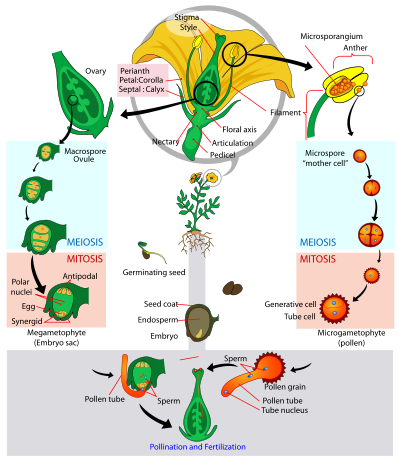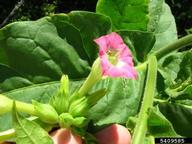
Reproduction
 Nicotiana tabacum
follows the reproduction trend of plants that undergo sexual
reproduction. Sexual reproduction is when the genetic
material from two parents is combined resulting in a new
individual. This
whole process occurs at the top of each tobacco plant in the
flowering region.
Nicotiana tabacum
follows the reproduction trend of plants that undergo sexual
reproduction. Sexual reproduction is when the genetic
material from two parents is combined resulting in a new
individual. This
whole process occurs at the top of each tobacco plant in the
flowering region.
The stamen (see image) is the part of the flower that
produces the male part that is used in reproduction, the pollen.
The pollen is a yellowish powder produced at the top of
the stamen in a structure called an anther (see image) for more
efficient dispersal when the time comes.
The female part of the plant is called the pistil (see
image). The pistil
contains a structure called a stigma (see image) at its top
which is where the pollen grain from another plant lands upon.
Sugar, which is produced by the stigma, is consumed by
the pollen to grow a tube called the pollen tube.
This pollen tube that is now formed acts as the “yellow
brick road” for the sperm to travel down and unite with an egg
located in the ovary (see image).
This actual transfer of pollen from the anther of one
plant to the stigma of another is called pollination.
 After fertilization has taken place, the single cell that
has just been fertilized undergoes the process of mitosis
resulting in a multi-cellular embryo that develops into a seed.
The ovary then dries up and eventually splits open to
disperse the seeds into the environment to grow a new adult
plant. The flowers
on the tobacco plant are colored specifically to attract certain
insects to carry its pollen grains to other plants and allow for
pollination to occur.
Today there are many degrees of genetic variation and controlled
cross-fertilization with various types of tobacco in order to
produce the desired variety for the specific purpose that it is
grown for. Many of
the natural processes of pollination are altered in this aspect
by controlling the various plants that pollinate with each
other.
After fertilization has taken place, the single cell that
has just been fertilized undergoes the process of mitosis
resulting in a multi-cellular embryo that develops into a seed.
The ovary then dries up and eventually splits open to
disperse the seeds into the environment to grow a new adult
plant. The flowers
on the tobacco plant are colored specifically to attract certain
insects to carry its pollen grains to other plants and allow for
pollination to occur.
Today there are many degrees of genetic variation and controlled
cross-fertilization with various types of tobacco in order to
produce the desired variety for the specific purpose that it is
grown for. Many of
the natural processes of pollination are altered in this aspect
by controlling the various plants that pollinate with each
other.
Logan Van Hoof, April 2011